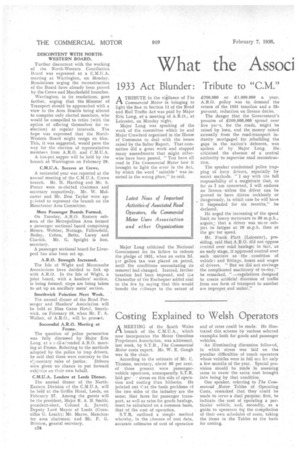Costing Explained to Welsh Operators
Page 78

If you've noticed an error in this article please click here to report it so we can fix it.
MEETING of the South Wales Pi branch of the C.M.U.A„ which now incorporates the Motor Omnibus Proprietors Association, was addressed, last week, by S.T.R., The Commercial Motor costs expert. Mr. W. E. Gough was in the chair.
According to the estimate of Mr. C. Thomas, secretary, about 50 per cent. of those present were passengervehicle operators, consequently, S.T.R. laid grer stress on this side of operation and costirg than hitherto. He pointed out tat the basic problems of the two sides of the industry are the same; that fares for passenger transport, as well as rates for goods haulage, must be calculated on a common basis, that of the cost of operation.
S.T.R. outlined a simple method whereby, in the absence of cost data, accurate estimates of cost of operation and of rates could he made. He illustrated this scheme by various selected examples both for goods and passenger vehicles.
• An illuminating discussion followed, in which stress was laid on the peculiar difficulties of coach operators whose vehicles were in full use for only a few months of the year. Special provision should be made in assessing rates to cover the extra cost brought into being by that condition. One speaker, referring to The Commercial _Motor Tables of Operating Costs, remarked that they could be made to serve a dual purpose; first, to indicate the cost of operating a particular vehicle, and, secondly, as a guide to operators liag the compilation of their own schedules of costs, taking the items in the Tables as the basis for costing.




































































































































































